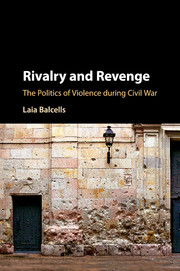Book contents
- Frontmatter
- Dedication
- Contents
- List of Figures
- Acknowledgments
- Conventions
- Preface
- PART I
- PART II
- 3 History of the Spanish Civil War (1936–1939)
- 4 Executions and Massacres During the Spanish Civil War
- 5 Bombardments During the Spanish Civil War
- PART III
- Appendix
- Bibliography
- Index
- Miscellaneous Endmatter
5 - Bombardments During the Spanish Civil War
from PART II
Published online by Cambridge University Press: 18 May 2017
- Frontmatter
- Dedication
- Contents
- List of Figures
- Acknowledgments
- Conventions
- Preface
- PART I
- PART II
- 3 History of the Spanish Civil War (1936–1939)
- 4 Executions and Massacres During the Spanish Civil War
- 5 Bombardments During the Spanish Civil War
- PART III
- Appendix
- Bibliography
- Index
- Miscellaneous Endmatter
Summary
“I heard an old man saying that the fighter planes had very meticulously bombed the most central points of the city, as if they had calculated it millimeter by millimeter.”
Montserrat Roig, Ramona, AdéuINTRODUCTION
In Chapter 2, I developed a theory on the determinants of direct violence in civil wars, with a focus on conventional civil wars. In this chapter, I extend my theoretical framework to indirect violence, and I generate a set of hypotheses that are tested with data on bombardments perpetrated by fascist armed forces (under Franco's leadership) in the region of Catalonia during the Spanish Civil War.
Following the taxonomy presented in Chapter 2, indirect violence is perpetrated with heavy weaponry (e.g., bomber aircraft, field artillery, naval gunfire) and does not require face-to-face interaction with victims; indirect violence can consist of aerial, artillery, or maritime bombardments.
As explained in Chapter 2, there are two main dimensions over which indirect violence differs from direct violence, and that make their respective theoretical explanation necessarily distinct: on the one hand, direct violence is perpetrated by an armed group in the territories they control, whereas indirect violence is mostly perpetrated in territories under the rival's control. On the other hand, direct violence implies an interaction between armed groups and civilians: this is not the case for indirect violence, which therefore leaves less room for civilian agency.
The use of air power became widespread during World War II, thanks to the technological development during World War I (Overy, 1980). The Spanish Civil War was the first conflict of the twentieth century in which air forces played an essential role (Payne, 2010: 471). Many bombs were dropped on cities full of noncombatants (Balcells 1987: 34; Leitz 1999). Since then, bombings against civilian targets have been frequent in any war where armed groups have access to air power. Artillery is much older than air power, but the underlying trend in artillery has been an increase in range, precision, and payloads, which has enabled it to reach “strategic” targets – deep inside enemy lines – rather than targets on the front or its immediate rear and so it can work much as a substitute for air power.
- Type
- Chapter
- Information
- Rivalry and RevengeThe Politics of Violence during Civil War, pp. 130 - 148Publisher: Cambridge University PressPrint publication year: 2017



